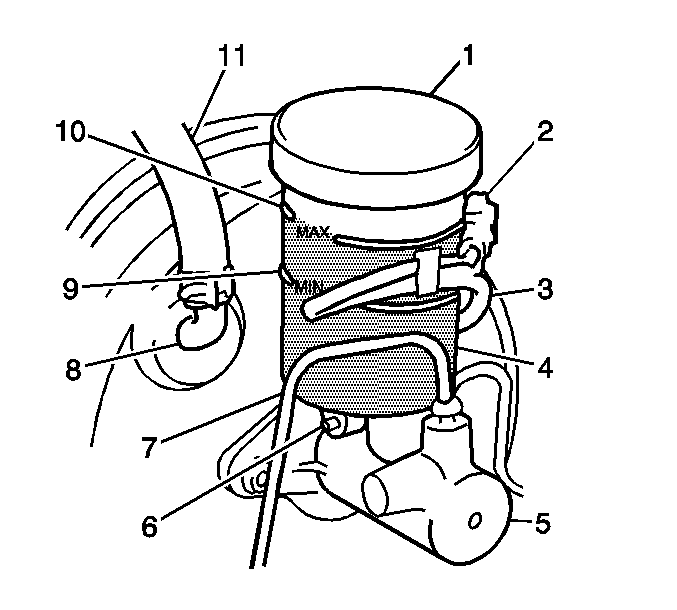Master Cylinder Replacement Non-ABS
Removal Procedure
Caution: Brake fluid may irritate eyes and skin. In case of contact, take the
following actions:
• Eye contact--rinse thoroughly with water. • Skin contact--wash with soap and water. • If ingested--consult a physician immediately.
Notice: Brake fluid will damage electrical connections and painted surfaces. Use shop cloths, suitable containers, and fender covers to prevent brake fluid from contacting these areas. Always re-seal and wipe off brake fluid containers to prevent spills.
- Disconnect the reservoir fluid level connector (2).
- Clean the reservoir and the master cylinder.
- Remove the reservoir. Refer to Master Cylinder Reservoir Replacement .
- Disconnect the brake pipes from the master cylinder.
- Remove the attaching nuts.
- Remove the master cylinder from the brake booster.
- Disassemble, inspect, and reassemble the master cylinder, if necessary. Refer to Master Cylinder Overhaul .

Installation Procedure
- Adjust the booster piston rod. Refer to the Adjustment Procedure in Power Vacuum Brake Booster Replacement .
- Bench bleed the master cylinder. Refer to Master Cylinder Bench Bleeding .
- Install the master cylinder (5) to the brake booster. Secure with 2 master cylinder attaching nuts.
- Connect the hydraulic lines.
- Install the reservoir. Refer to Master Cylinder Reservoir Replacement .
- Connect the reservoir fluid level connector.
- Fill the reservoir. Refer to Master Cylinder Reservoir Filling .
- Bleed the hydraulic brake system. Refer to Hydraulic Brake System Bleeding .
- Inspect the hydraulic brake system for leaks. Refer to Brake Fluid Leak .
- Inspect the brake pedal travel. Refer to Brake Pedal Travel .
- Perform the brake test. Refer to Brake System Testing.
Notice: Use the correct fastener in the correct location. Replacement fasteners must be the correct part number for that application. Fasteners requiring replacement or fasteners requiring the use of thread locking compound or sealant are identified in the service procedure. Do not use paints, lubricants, or corrosion inhibitors on fasteners or fastener joint surfaces unless specified. These coatings affect fastener torque and joint clamping force and may damage the fastener. Use the correct tightening sequence and specifications when installing fasteners in order to avoid damage to parts and systems.

Tighten
Tighten the master cylinder attaching nuts to 13 N·m (115 lb in).
Tighten
Tighten the flare nuts to 16 N·m (12.0 lb ft).
Master Cylinder Replacement ABS
Removal Procedure
Caution: Brake fluid may irritate eyes and skin. In case of contact, take the
following actions:
• Eye contact--rinse thoroughly with water. • Skin contact--wash with soap and water. • If ingested--consult a physician immediately.
Notice: Brake fluid will damage electrical connections and painted surfaces. Use shop cloths, suitable containers, and fender covers to prevent brake fluid from contacting these areas. Always re-seal and wipe off brake fluid containers to prevent spills.
- Disconnect the reservoir fluid level connector (2).
- Clean the reservoir and the master cylinder.
- Remove the reservoir. Refer to Master Cylinder Reservoir Replacement .
- Disconnect the brake pipes from the master cylinder.
- Disconnect the brake pipes (1,4) from the proportioning valve (3).
- Remove the master cylinder attaching nuts.
- Remove the master cylinder with the proportioning valve from the brake booster.
- Separate the proportioning valve from the master cylinder. Refer to Proportioning Valve Replacement .
- Disassemble, inspect, and reassemble the master cylinder, if necessary. Refer to Master Cylinder Overhaul with ABS .


Installation Procedure
- Adjust the booster piston rod. Refer to the Adjustment Procedure in Power Vacuum Brake Booster Replacement .
- Bench bleed the master cylinder. Refer to Master Cylinder Bench Bleeding .
- Install the proportioning valve to the master cylinder. Refer to Proportioning Valve Replacement .
- Install the master cylinder (5) to the brake booster.
- Connect the hydraulic lines.
- Install the reservoir. Refer to Master Cylinder Reservoir Replacement .
- Connect the reservoir fluid level connector.
- Fill the reservoir. Refer to Master Cylinder Reservoir Filling .
- Bleed the hydraulic brake system. Refer to Hydraulic Brake System Bleeding .
- Inspect the hydraulic brake system for leaks. Refer to Brake Fluid Leak
- Inspect the brake pedal travel. Refer to Brake Pedal Travel .
- Perform the brake test. Refer to Brake System Testing.
Notice: Use the correct fastener in the correct location. Replacement fasteners must be the correct part number for that application. Fasteners requiring replacement or fasteners requiring the use of thread locking compound or sealant are identified in the service procedure. Do not use paints, lubricants, or corrosion inhibitors on fasteners or fastener joint surfaces unless specified. These coatings affect fastener torque and joint clamping force and may damage the fastener. Use the correct tightening sequence and specifications when installing fasteners in order to avoid damage to parts and systems.

Tighten
Tighten the master cylinder attaching nuts to 13 N·m (115 lb in).
Tighten
Tighten the flare nuts to 16 N·m (12.0 lb ft).
